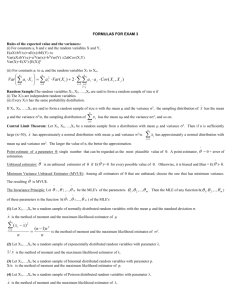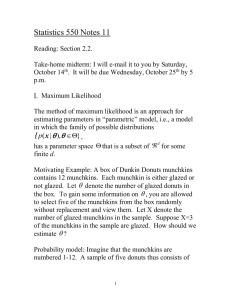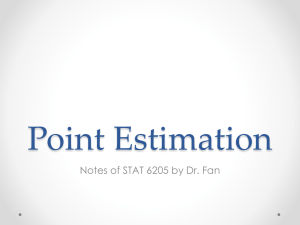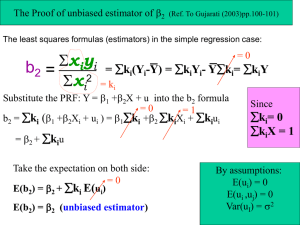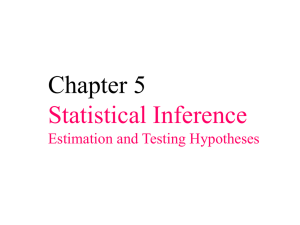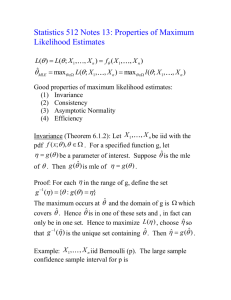STAT 211
advertisement
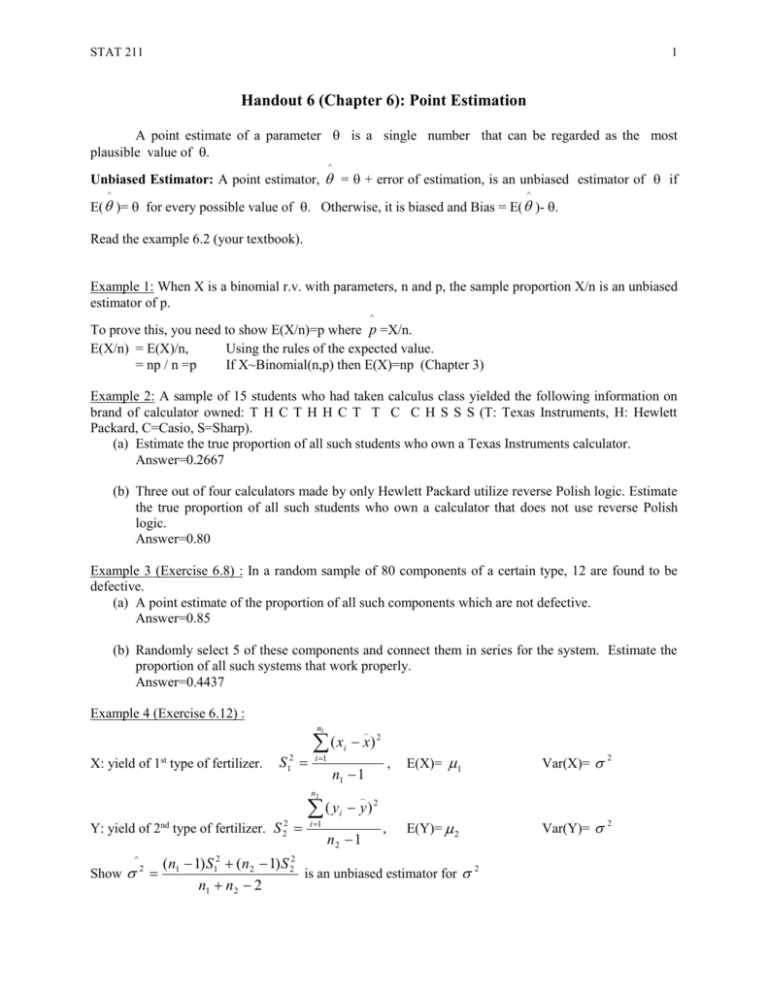
STAT 211 1 Handout 6 (Chapter 6): Point Estimation A point estimate of a parameter is a single number that can be regarded as the most plausible value of . ^ Unbiased Estimator: A point estimator, = + error of estimation, is an unbiased estimator of if ^ ^ E( )= for every possible value of . Otherwise, it is biased and Bias = E( )- . Read the example 6.2 (your textbook). Example 1: When X is a binomial r.v. with parameters, n and p, the sample proportion X/n is an unbiased estimator of p. ^ To prove this, you need to show E(X/n)=p where p =X/n. E(X/n) = E(X)/n, Using the rules of the expected value. = np / n =p If X~Binomial(n,p) then E(X)=np (Chapter 3) Example 2: A sample of 15 students who had taken calculus class yielded the following information on brand of calculator owned: T H C T H H C T T C C H S S S (T: Texas Instruments, H: Hewlett Packard, C=Casio, S=Sharp). (a) Estimate the true proportion of all such students who own a Texas Instruments calculator. Answer=0.2667 (b) Three out of four calculators made by only Hewlett Packard utilize reverse Polish logic. Estimate the true proportion of all such students who own a calculator that does not use reverse Polish logic. Answer=0.80 Example 3 (Exercise 6.8) : In a random sample of 80 components of a certain type, 12 are found to be defective. (a) A point estimate of the proportion of all such components which are not defective. Answer=0.85 (b) Randomly select 5 of these components and connect them in series for the system. Estimate the proportion of all such systems that work properly. Answer=0.4437 Example 4 (Exercise 6.12) : n1 X: yield of 1st type of fertilizer. S12 (x i 1 ^ Show 2 (n1 1) S (n2 1) S n1 n2 2 2 1 2 2 x) 2 , n1 1 n2 2 Y: yield of 2nd type of fertilizer. S 2 _ i (y i 1 E(X)= 1 Var(X)= 2 E(Y)= 2 Var(Y)= 2 _ i y) 2 n2 1 , is an unbiased estimator for 2 STAT 211 2 (n1 1) S12 (n2 1) S 22 2 n n 2 1 2 It means that you need to show E (n1 1) S12 (n2 1) S 22 (n1 1) (n2 1) E E S12 E S 22 n1 n2 2 n1 n2 2 n1 n2 2 (n1 1) (n2 1) 2 2 2 n1 n2 2 n1 n2 2 Example 5 (Exercise 6.13) : X1,X2,….,Xn be a random sample from the pdf f(x)=0.5(1+x), -1x1, ^ _ -11. Show that 3 X is an unbiased estimator for . ^ It means that you need show E . _ ^ E 3 E X 3 E ( X ) = chapter5 where 1 x2 x3 1 1 E ( X ) x 0.5(1 x)dx 0.5 0.5 , 1 1 3 1 2 3 2 3 3 2 1 1 ^ The standard error: The standard error of an estimator is its standard deviation ^ . The estimated standard error: The estimated standard error of an estimator is its estimated standard ^ deviation ^ = s ^ . The minimum variance unbiased estimator (MVUE): The best point estimate. Among all estimators ^ of that are unbiased choose the one that has minimum variance. The resulting is MVUE. ^ ^ Example 6: If we go back to example 1, the standard error of p is ^ Var p p np(1 p ) p(1 p) Var ( X ) ^ Var p 2 Chapter3 n n2 rulesof var iance n X ~ Binomial( n , p ) Var ( X ) np (1 p ) ^ Example 7: If we go back to example 5, the standard error of is 3 2 Var ( X ) 3 2 9 9 n n chapter5 9n 1 2 3 2 where Var(X)= E ( X 2 ) [ E ( X )] 2 3 9 9 Var 9Var X ^ ^ _ 1 x3 x4 1 1 1 0.5 E(X )= x 0.5(1 x)dx 0.5 4 1 3 4 3 4 3 3 1 1 2 2 p (1 p ) where n STAT 211 3 ^ _ Example 8: For normal distribution, x is the MVUE for . Proof is as follows. The following graphs are generated by creating 500 samples with size 5 from N(0,1) and calculating the sample mean and the sample median for each sample. Example 9 (Exercise 6.3): Given normally distributed data yield the following summary statistics. Variable thickness n 16 Mean 1.3481 Median 1.3950 TrMean 1.3507 Variable thickness Minimum 0.8300 Maximum 1.8300 Q1 1.0525 Q3 1.6425 StDev 0.3385 SE Mean 0.0846 (a) A point estimate of the mean value of coating thickness. (b) A point estimate of the median value of coating thickness. (c) A point estimate of the value that separates the largest 10% of all values in the coating thickness distribution from the remaining 90%. Answer=1.78138 (d) Estimate P(X<1.5) (The proportion of all thickness values less than 1.5) Answer=0.6736 (e) Estimated standard error of the estimator used in (a). Answer=0.084625 STAT 211 4 Boxplot of thickness 0.8 1.3 1.8 thickness Normal Probability Plot for thickness ML Estimates - 95% CI 99 ML Estimates 95 Mean 1.34812 StDev 0.327781 90 Goodness of Fit Percent 80 AD* 70 60 50 40 30 1.074 20 10 5 1 0.4 1.4 2.4 Data METHODS OF OBTAINING POINT ESTIMATORS 1. The Method of Moments (MME) Let X1,X2,….,Xn be a random sample from a pmf or pdf. For k=1,2,…., the kth population moment of the distribution is E(Xk). The kth sample moment is 1 n k xi . n i 1 STAT 211 5 Steps to follow : If you have only one unknown parameter (i) calculate E(X). (ii) 1 n 1 _ xi x . n i 1 equate it to (iii) Solve for unknown parameter (such as 1). If you have two unknown parameters, you also need to compute the following to solve two unknown parameters with two equations. (iv) calculate E(X2). (v) 1 n 2 xi . n i 1 equate it to (vi) Solve for the second unknown parameter (such as 2). If you have more than two unknown parameters, repeat the same steps for k=3,….. until you can solve it. _ Example 10: Show that MME of the parameter in Poisson distribution is x There is one unknown parameter. The 1th population moment of the distribution is E(X)= . _ The 1th sample moment is x _ Then Example 11: x is the MME for Find the MME for the parameters and in gamma distribution. There are two unknown parameters. The 1th population moment of the distribution is E(X)= . _ The 1th sample moment is x _ Then = x but this did not help to solve for any unknown parameter. We need to continue the steps. The 2nd population moment of the distribution is E(X2)= 2(1+). The 2nd sample moment is Then 2(1+)= 1 n 2 xi n i 1 1 n 2 xi n i 1 Since we have 2 unknown parameters and two equations, we can solve for the unknown parameters. 2 _ x x i 2 ( x) , respectively i 1 The MME for and are and 2 _ n _ x xi x i 1 n _ Example 12: Find the MME for the parameters and 2 in normal distribution. There are two unknown parameters. The 1th population moment of the distribution is E(X)= . STAT 211 6 _ The 1th sample moment is x _ Then = x but we still need to solve for the second unknown parameters. We need to continue the steps. The 2nd population moment of the distribution is E(X2)= 2 +2 . The 2nd sample moment is 1 n 2 xi n i 1 1 n 2 Then + = xi n i 1 2 2 Then this can be solved for the second unknown parameter. 2 _ x x i _ , respectively i 1 2 The MME for and are x and n n 2. The Method of Maximum Likelihood (MLE) Likelihood function is the joint pmf or pdf of X which is the function of unknown values when x's are observed. The maximum likelihood estimates are the values which maximize the likelihood function. Steps to follow: (i) Determine the likelihood function. (ii) Take the natural logarithm of the likelihood function. (iii) Take a first derivative with respect to each unknown and equate it to zero (if you have m unknown parameters, you will have m equations as a result of derivatives). (iv) Solve for unknown 's. (v)Check if it really maximizes your function by looking at a second derivative. _ Example 13: Show that MLE of the parameter in Poisson distribution is x There is one unknown parameter. L=Likelihood = p(x1,x2,….,xn) = p(x1)p(x2)….p(xn) by independence e x1 e x2 e x3 e x n e n i = . . …….. = n x1! x2 ! x3 ! xn ! xi ! x ln(L)= n i 1 x ln( ) ln( x !) i i d ln( L) xi 0 then x_ n d d 2 ln( L) xi d2 2 ^ _ 0 then the MLE of is x ^ ^ ^ The Invariance Principle: Let 1 ., 2 ,..., m be the MLE's of the parameters 1 , 2 ,..., m . Then the ^ ^ ^ MLE of any function h( 1 , 2 ,..., m ) of these parameters is the function h( 1 ., 2 ,..., m ) of the MLE's STAT 211 7 Example 14: (1) Let X1,…,Xn be a random sample of normally distributed random variables with the mean and the standard deviation . n _ The method of moment estimates of and 2 are x and _ ( xi x ) 2 i 1 n n _ The maximum likelihood estimates of and 2 are x and (n 1) s 2 , respectively n _ ( xi x ) 2 i 1 n (n 1) s 2 , respectively n (2) Let X1,…,Xn be a random sample of exponentially distributed random variables with parameter . _ The method of moment estimate and the maximum likelihood estimate of are 1 / x . (3) Let X1,…,Xn be a random sample of binomial distributed random variables with parameter p. The method of moment estimate and the maximum likelihood estimate of p are X/n. (4) Let X1,…,Xn be a random sample of Poisson distributed random variables with parameter . _ The method of moment estimate and the maximum likelihood estimate of are x . All the estimates above are unbiased? Some Yes but others No. (will be discussed in class) Example 15 (Exercise 6.20): random sample of n bike helmets are selected. X: number among the n that are flawed =0,1,2,…..,n p=P(flawed) (a) Maximum likelihood estimate (MLE) of p if n=20 and x=3? (b) Is the estimator in (a) unbiased? (c) Maximum likelihood of (1-p)5 (none of the next five helmets examined is flawed)? (d) Instead of selecting 20 helmets to examine, examine the helmets in succession until 3 flawed ones are found. What would be different in X and p? Example 16 (Exercise 6.22): X: the proportion of allotted time that a randomly selected student spends working on a certain aptitude The pdf of x is f(x;)= ( 1) x , 0x1, >-1. A random sample of 10 students yield the data: 0.92, 0.79, 0.90, 0.65, 0.86, 0.47, 0.73, 0.97, 0.94, 0.77. (a) Obtain the MME of and compute the estimate using the data. 1 x 2 1 E ( X ) x ( 1) x dx ( 1) 2 0 2 0 1 _ Set E(X)= x and then solve for . _ _ ~ The given data yield x = 0.80 then the method of moment estimator for is 2 x 1 _ 1 x 2(0.8) 1 =3 1 0.8 STAT 211 8 (b) Obtain the MLE of and compute the estimate using the data. n L=Likelihood= i 1 n n i 1 i 1 f ( xi ) ( 1) xi ( 1) n xi ln(L)= n ln( 1) n ln( x ) i i 1 n d ln( L) n ln( xi ) =0 then solve for . d 1 i 1 n The given data yield ln( x ) -2.4295 i 1 i then the maximum likelihood estimator for is n ^ n ln( xi ) i 1 n ln( xi ) (10 2.4295) =3.1161 ((2.4295)) i 1 Proposition: Under very general conditions on the joint distribution of the sample when the sample size is large, the MLE of any parameter is approximately unbiased and has a variance that is nearly as small as can be achieved by an estimator.


